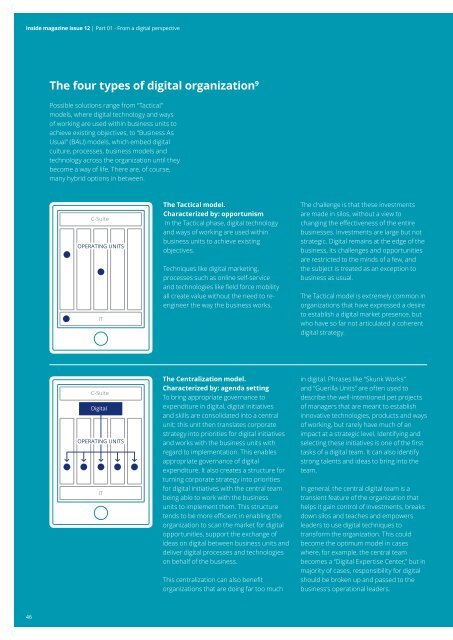lu_inside12-full
You also want an ePaper? Increase the reach of your titles
YUMPU automatically turns print PDFs into web optimized ePapers that Google loves.
Inside magazine issue 12 | Part 01 - From a digital perspective<br />
The four types of digital organization 9<br />
Possible so<strong>lu</strong>tions range from “Tactical”<br />
models, where digital technology and ways<br />
of working are used within business units to<br />
achieve existing objectives, to “Business As<br />
Usual” (BAU) models, which embed digital<br />
culture, processes, business models and<br />
technology across the organization until they<br />
become a way of life. There are, of course,<br />
many hybrid options in between.<br />
The Tactical model.<br />
Characterized by: opportunism<br />
In the Tactical phase, digital technology<br />
and ways of working are used within<br />
business units to achieve existing<br />
objectives.<br />
Techniques like digital marketing,<br />
processes such as online self-service<br />
and technologies like field force mobility<br />
all create va<strong>lu</strong>e without the need to reengineer<br />
the way the business works.<br />
The challenge is that these investments<br />
are made in silos, without a view to<br />
changing the effectiveness of the entire<br />
businesses. Investments are large but not<br />
strategic. Digital remains at the edge of the<br />
business, its challenges and opportunities<br />
are restricted to the minds of a few, and<br />
the subject is treated as an exception to<br />
business as usual.<br />
The Tactical model is extremely common in<br />
organizations that have expressed a desire<br />
to establish a digital market presence, but<br />
who have so far not articulated a coherent<br />
digital strategy.<br />
The Centralization model.<br />
Characterized by: agenda setting<br />
To bring appropriate governance to<br />
expenditure in digital, digital initiatives<br />
and skills are consolidated into a central<br />
unit; this unit then translates corporate<br />
strategy into priorities for digital initiatives<br />
and works with the business units with<br />
regard to implementation. This enables<br />
appropriate governance of digital<br />
expenditure. It also creates a structure for<br />
turning corporate strategy into priorities<br />
for digital initiatives with the central team<br />
being able to work with the business<br />
units to implement them. This structure<br />
tends to be more efficient in enabling the<br />
organization to scan the market for digital<br />
opportunities, support the exchange of<br />
ideas on digital between business units and<br />
deliver digital processes and technologies<br />
on behalf of the business.<br />
This centralization can also benefit<br />
organizations that are doing far too much<br />
in digital. Phrases like “Skunk Works”<br />
and “Guerilla Units” are often used to<br />
describe the well-intentioned pet projects<br />
of managers that are meant to establish<br />
innovative technologies, products and ways<br />
of working, but rarely have much of an<br />
impact at a strategic level. Identifying and<br />
selecting these initiatives is one of the first<br />
tasks of a digital team. It can also identify<br />
strong talents and ideas to bring into the<br />
team.<br />
In general, the central digital team is a<br />
transient feature of the organization that<br />
helps it gain control of investments, breaks<br />
down silos and teaches and empowers<br />
leaders to use digital techniques to<br />
transform the organization. This could<br />
become the optimum model in cases<br />
where, for example, the central team<br />
becomes a “Digital Expertise Center,” but in<br />
majority of cases, responsibility for digital<br />
should be broken up and passed to the<br />
business’s operational leaders.<br />
46


